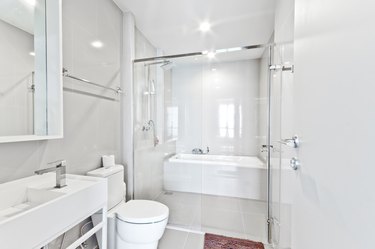
Your toilet gets a lot of use, so you can't ignore clogs, which can be not only annoying but also messy. You don't want to make a bigger mess out of a simple toilet repair, and you certainly don't want to get hurt in the process. It's tempting to reach for chemical drain openers when you have plumbing clogs, but resist the temptation to tackle toilet clogs with Liquid-Plumr or any chemical clog-removal products.
Store-bought chemical drain openers are caustic, which means they're potentially dangerous to you and are often hard on your plumbing system. They aren't designed for the twists and turns of toilet piping, so they won't fix the clog. Worse, when you try to use a plunger or a snake to remedy the problem, the chemicals can splash out of the toilet, causing serious burns. You should never use chemical drain openers on toilet clogs, but you can use other time-tested and safer methods to get things flowing again.
Video of the Day
Video of the Day
Things You'll Need
Toilet auger (sewer snake)
How to Clear a Clogged Toilet
Step 1: Prepare the Area
Clear rugs and other things away from the toilet since dealing with a clog can get messy. You can put down old towels or rags to soak up splashing toilet water if you want. Plugging the sink and bathtub drain in the bathroom can make plunging more effective, although it's not required.
Step 2: Plunge the Toilet Clog
Start with a bell or bellows type plunger for the simple and often effective clog removal method of plunging. This type of plunger forms a stronger, more airtight seal with its bell-shaped end and an extended flange, which is why it's often called a toilet plunger. It differs from sink plungers, which are straight across and make it difficult to get a good seal in a toilet. With a few good, straight pumps, you can probably dislodge the clog. Fill the bell with water to help with the force so you're not plunging air. Position the plunger so the flange is in the toilet drain hole. Hold the plunger vertically to maintain a good seal. Use a forceful up and down motion with the plunger for about 10 to 20 seconds to remove the clog.
Step 3: Use a Toilet Snake
Put on some gloves to protect your hands from the mess that's stopping up your toilet if the plunging method doesn't work. Insert the end of the toilet auger (also called a plumbing snake) down the toilet drain. Wiggle it around until it stops. It may stick several times before you reach the actual mass of the clog. When you think you've reached something that won't budge, spin the snake clockwise, and try to hook the clog. Then pull, and the clog should break up.
Remove the Toilet
Remove the toilet from the floor as a last resort before calling a plumber if you feel comfortable doing so. This allows you to reach deeper clogs by snaking the line. Drain all water from the toilet and unscrew it from the floor. Then use an auger to clear the clogs. You'll need a new toilet wax ring to reinstall the toilet if you remove it.
Call a Plumber
Call a plumber instead of breaking out the chemical drain opener if all else fails. When you hire a plumber, you get access to professional tools and expertise, and you get to stay clean. If you've already used drain opener, let the plumber know so they can bring appropriate protective gear before facing a toilet full of caustic chemicals.